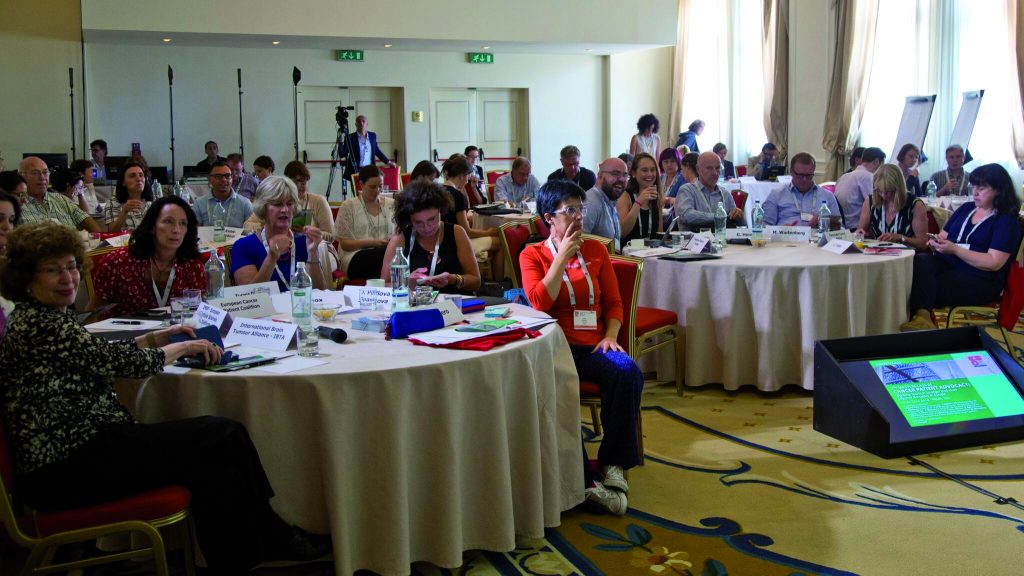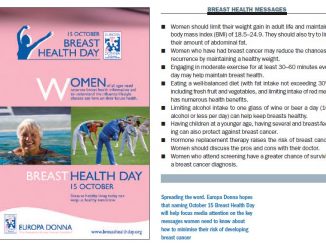
As researchers, regulatory bodies and health systems give patients more of a voice in consultation and decision making, advocacy groups are questioning what it really means to represent the patient view. Simon Crompton reports.
Nothing about us without us. So goes the mantra of patient organisations around the world, asserting their right to have a say in health decision-making.
Five words that make patient involvement sound so simple. But a growing body of patient and cancer organisations are asserting that it’s anything but simple: the whole idea of ‘patient representation’ is flawed and needs a re-think, they say.
Conventional models of patient representation bring risks. For some committees, companies and organisations, having a patient on the panel simply means they can tick the patient involvement box and move on. At least that’s the view of Deb Maskens, founder of Kidney Cancer Canada and Vice Chair of the International Kidney Cancer Coalition (IKCC).
“It’s far too easy for health technology assessment organisations or pharmaceutical companies to say that they have a patient on their committee and therefore they have had patient input,” she says.
Equally, long-standing patient representatives can lose their independent perspective as they become embedded into formal committees and organisational norms. “Some even see it as a conflict to be in touch with the patient advocacy group – that if they consult patient organisations or advocates they’ve somehow gone over to the other side and will introduce bias. The esteemed people on the committee become their tribe and closest affiliation.”
“For some, having a patient on the panel
simply means they can tick the patient involvement box”
And then there’s the question of how ‘representative’ patient ‘representatives’ can actually be. Several European patient organisations have become concerned about the number of committees where one or two firmly established patients are there to represent all cancer patients – even in discussions that relate to a type or stage of cancer entirely different from their own. That situation, says Maskens, is “absolutely ludicrous”.
Bettina Ryll, founder of the Melanoma Patient Network Europe, Chair of ESMO’s patient advocacy working group and a patient representative on many committees, agrees. As long as patients on committees are expected to represent the views of hundreds of people whose experiences may be entirely different from their own, they are in a very vulnerable and ineffective position.
“It’s very very difficult to be representative. I’m fed up with being challenged about this wherever I go. People say: ‘Yes, but how representative are you anyway?’ and this is a very easy way to take out the patient perspective if it’s not convenient. It’s an especially pressing issue because not everyone in health systems is happy with patient voices becoming more integrated into health decision-making. Undermining difficult patient views happens very frequently, and in the end, just the ‘yes-sayers’ are left over. That’s not sufficient.”
Those who represent patient interests in complex technical discussions are also vulnerable to criticism. Discussions on the relative risks and benefits of specific drugs, for example, may require some expert knowledge from the patient representative. But people with that degree of understanding are then accused of no longer being representative of most patients. “It’s a double bind,” says Ryll. “You can’t win.”
Evidence-based advocacy
But there may be a way forward. A growing number of patient advocacy groups are adopting the idea of ‘evidence-based advocacy’ to replace conventional ideas of ‘representation’. It involves letting go of any expectation that one patient should be able to represent everyone. Instead, patients on groups or committees gather, filter and convey information about the patient perspective on a particular issue from a variety of sources. They become a conduit for evidence from the relevant patient community, not a narrator of personal experience or opinion.
“I don’t in any way want to take away from the value of people conveying their personal narratives,” says Maskens. “But patient representatives now need to be equipped with a new skill set.
“Those on established committees should have to have an ear to the ground of what is happening in that disease space. There are thousands of people online in some form, and so before a review decision comes up, patient representatives can take a deeper dive into that patient community – listening to them, asking open-ended questions.
“If we are the ones with access
to this type of primary data,
it’s our responsibility to use it”
“If a committee includes a patient who cannot demonstrate how they regularly engage with a broader community, then I think we should be calling that representation into question. In the worst cases that representation is bringing in commentary that is subjective and not in any way evidence-based. It’s come out of the blue sky.”
According to Ryll, there are plenty of opportunities for gathering information from specific groups of patients, including conducting online surveys through software such as Survey Monkey, gathering opinion at conferences, and conducting Facebook polls.
“Because of social media, it’s never been easier to gather information,” she says. “It’s not that hard to produce data.”
A recent pilot study from the European Medicines Agency showed the potential of this kind of evidence gathering. The EMA worked with the Melanoma Patient Network Europe and Myeloma Patients Europe to investigate how studies into patient preferences might inform the regulatory review of medicines. Could a uniformity of view about the relative risks and benefits of drugs be found in patient subgroups that could usefully inform market authorisation decisions?
A survey of 139 patients with advanced (stage IV) cancers, along with carers, advocates, regulators and health professionals, suggested it might. It found that patients were significantly more accepting of the potential risks of a treatment than their carers – and that patient advocates were more risk averse than either (see panel overleaf). Ryll says that this kind of study indicates that the views of advocates are not necessarily those of patients with advanced cancer, and provides vital information on what a specific group of patients really think. The EMA and Myeloma UK are now working on a follow-up study to find out more about the degree of risk patients are prepared to accept in treatments.
According to Francesco Pignatti, Head of Oncology at the EMA, this work is part of a general movement from patients, regulators, industry and academia to find the best ways of eliciting the values of specific groups of patients – with different cancers, at different stages – and using this knowledge to inform treatment decision-making and regulatory and payment decisions.
“It’s an important part of our work to get quantitative data,” he says, “to elicit whether there is a heterogeneity of views and to get a comprehensive understanding of how the different groups – elderly versus young, for example – think.”
The changing role of advocacy
There are many other examples of patient organisations taking on the role of ‘evidence gatherers’, rather than ‘representatives’, to best make the case for treatment improvements. In 2013, for example, the CML Advocates Network – an international network of organisations supporting patients with chronic myelogenous leukaemia, made an impact with its survey into how well patients stuck to their Glivec prescriptions.
The survey received more than 2,150 responses online and almost 400 on paper, and resulted in a highly influential report, documenting the surprising extent to which patients on long-term medication miss doses, even when their illness is potentially life-threatening.
It illustrated how successful advocacy organisations could be in gathering information that doctors and official bodies might have difficulty uncovering, and has paved the way for similar work by other patient bodies.
Who can speak for patients?
The level of risk that patients who are dying of cancer are prepared to take in the hope of some benefit may be underestimated even by the people closest to them. This was one of the findings of a pilot study conducted by the European Medicines Agency.
A group of regulators, healthcare professionals, patients, carers and advocates were asked about what percentage increase in the probability of toxicity they would be prepared to accept for every 1% increase in the probability of surviving 12 months (Clin Pharmacol Ther 99:548–554).
Responses showed that regulators and healthcare professionals were more risk averse than the group of patients, carers and advocates. More surprising were differences within the melanoma subgroup, which consisted of stage IV patients, stage IV carers and advocates. Patients said they would accept more risk than carers, and much more risk than advocates. Indeed advocates were more risk averse than the regulators.
While the results of this subgroup analysis need to be confirmed, they provide ammunition for those who argue that, where priorities and preferences are concerned, every effort must be made to consult widely among the affected patient population, to allow their authentic voice to be heard.
At a Masterclass in Cancer Patient Advocacy held by the European School of Oncology in June, organisations for patients with kidney cancer, neuroendocrine tumours, pancreatic cancer and lymphoma gave presentations on how they were contributing to discussion and advancing treatment through gathering information.
Charlotte Roffiaen, Regional Director of Lymphoma Coalition Europe, described how the coalition’s patient experience survey and database on access to care had helped iden-tify the priorities of patients with different disease subtypes. Its findings are being used in discussions with regulators and pharmaceutical companies about patient unmet needs.
Ali Stunt, Chief Executive of Pancreatic Cancer Action, argued that patient surveys play a vital role in advocacy. They provide richer information about the real impact of disease and treatments than disease statistics, and also move beyond the purely anecdotal. Her organisation’s 2015 patient and carer survey collected 400 responses via Survey Monkey, and provided important evidence of inequalities in care.
According to Ryll, regulators and HTA Boards are welcoming this new type of advocacy. If anything, she says, it’s a challenge to advocates from patient organisations, because it is demanding and needs resources. She’d like to see public and educational bodies support advocacy organisations in becoming expert at producing qualitative and quantitative data.
“We are sitting on a phenomenal resource that can have a huge impact on what our patients are exposed to, so it’s not just an opportunity but also a responsibility. If we are the ones with that type of access to primary data, it’s our responsibility to use it and learn on behalf of our patients.”
Advocating on broader issues
However, not all patient organisations believe that collecting data about the detail of patient experiences and preferences should be a core concern. Large umbrella organisations such as Europa Donna – the European Breast Cancer Coalition – and the European Cancer Patient Coalition (ECPC) believe that their constitutional frameworks and relationships with members ensure they can represent a wide range of people, and gain input on specialist areas when necessary.
ECPC President Francesco de Lorenzo says there is a danger of patient advocates getting too involved in the minutiae of decision-making in areas which can require some expert knowledge. Their priority has to be campaigning against inequalities in cancer treatment and care.
“We have to make clear what the role of the patient advocate is. I don’t think they should become professionals,” says De Lorenzo, a colorectal cancer survivor and medical doctor, who has been involved in patient advocacy since 1997. The ECPC has represented patients in initiatives with the professional societies for medical and radiation oncologists, and with European bodies such as the Expert Group on Cancer Control. It also selects cancer patient representatives to take part in the EMA’s benefit–risk evaluations.
“I think patient advocates should raise awareness of patients’ new needs and defend the right to equal access to innovative and sustainable medicines, and access to clinical trials. That doesn’t mean they should be involved in supervising clinical trials. We need to trust the experts and scientists: they’re not against the patient. That’s the position of the ECPC.”
He says that the organisation gathers a wide range of perspectives on specific cancers and circumstances through its diverse board and close relationships with its 400 member organisations in 44 countries. They provide the direction and the messages for advocacy.
“We know that inequalities are the worst thing affecting patients, so we want to find and fight the worst disparities in treatment. We know that this is the problem that each patient organisation is fighting. We want to ensure meaningful innovative treatments for all who need it. So we are working with members of the European Parliament to bring change.”
Susan Knox, Chief Executive Officer of Europa Donna, believes that the organisation’s diverse board and membership in 47 countries ensures that it represents and can draw on a wide range of cancer experiences. Constitutionally, Europa Donna is set up to meet the needs of its member organisations. All members agree on Europa Donna’s campaigning priorities, which are reviewed twice a year at General Assembly meetings.
“We’ve been operating for 22 years, and I can honestly say that nobody has ever raised their hand and said, ‘We’re not sure you’re representing us,’ she says.

17 European/international organisations at the ESO Masterclass on Cancer Patient Advocacy, in June
But is there a danger that some patient representatives get too engrained in systems and lose their independent perspective? Knox acknowledges the risk, but says that the fast turnover of its board members ensures against this.
“It’s true that there are more and more requests from professional organisations for us to participate in their activities: Europa Donna is now being asked to serve on trial committees, be part of the international breast groups, understand very complicated trial protocols, get involved in all kinds of consent forms. To be a patient representative in some of these areas requires an expertise that isn’t always easy to find.”
So Europa Donna provides training, particularly in the research field, so that they can do their job effectively. “This means that patient representatives can do an effective job, and not just rubber stamp what is handed to them by organisations and scientific investigators.”
More than one approach
So where next for patient advocates? Keeping independent, having expert knowledge, being informed by data, being alert to grass roots opinion, pushing for equity of service: it’s a ridiculously tall order to keep everyone happy.
Organisations such as the EMA are excited about the potential of evidence-based advocacy. But they are not expecting it to provide all the answers.
“My view is that patient involvement is best achieved through a collection of approaches,” says Pignatti. “We don’t expect patients to be taking over the role of the regulators, but the decision will be much more informed by this variety of approaches, sometimes expert opinion, sometimes a more population-based study on patient preferences and so on.”
EMA’s patient relations coordinator, Nathalie Bere, agrees. “Sometimes a single conversation with a single patient will highlight something really important to follow up,” she says. “It’s not that there’s one best way to engage with patients. It depends on what the level of activity is, and what information you want at that particular time. You need a toolkit of approaches you can choose from.”
As for Ryll, she just believes that things can be, and should be, so much better.
“I’m not a missionary for evidence-based advocacy,” she says. “I’m just trying to make a difference in melanoma. But for us, having an evidence base to your advocacy takes away the criticisms of how representative you are. It brings you closer to your population. It guards against bias. And, in a way, it’s liberating, because you’re free to explore and measure. It’s not about being right. It’s about understanding what the problem is.”





